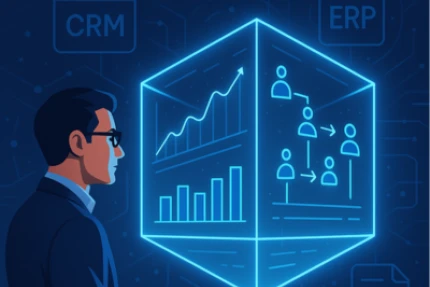
In today’s dynamic investment landscape, understanding key performance indicators (KPIs) is crucial for evaluating the health and growth potential of SaaS companies. Investors consistently prioritize and track portfolio company KPIs to gauge both financial health and operational efficiency. They use the KPIs to identify opportunities, assess risks, and drive informed decision-making and encourage the management teams to do the same.
Based on discussions during a series of investor roundtables, this article explores the most critical SaaS metrics that investors care about. Read on for insights into how companies can optimize these finance and sales KPIs to stand out in a competitive capital raising environment.
Finance Metrics: Prioritizing Sustainable Growth
Revenue Growth and Gross Margin
When evaluating SaaS companies, investors often focus on metrics that reflect business growth and unit economics. Revenue growth and gross margin are among the most important indicators of financial health. Revenue growth is typically the primary sign that a business model is working. It highlights the company’s ability to scale, indicating whether it can expand its customer base and increase sales over time. As one SaaS investor explained, “Revenue growth is the clearest signal of whether a business can scale efficiently.”
“Revenue growth is the clearest signal of whether a business can scale efficiently.”
Gross Margin, on the other hand, reflects how capital efficient a company is and whether it’s truly a software business. A high gross margin suggests a capital-efficient business, which is highly attractive to investors. A gross margin above industry standards often signals operational strength. “Gross margin can tell you if a company is really a tech-driven business or hiding service-heavy revenue.” High margins suggest scalability, while lower-than-expected margins can raise concerns about hidden inefficiencies or a reliance on manual processes.
“Gross margin can tell you if a company is really a tech-driven business or hiding service-heavy revenue.”
Free Cash Flow Margin and Rule of 40
Free cash flow margin is another key indicator of financial sustainability, offering insight into whether a company can grow without relying on constant capital infusions. As one investor put it, “Free cash flow is a critical measure of a company’s ability to reinvest in itself without having to constantly raise money.” Strong free cash flow provides companies with the flexibility to drive growth, improve product offerings, and expand into new markets.
“Free cash flow is a critical measure of a company’s ability to reinvest in itself without having to constantly raise money.”
Many investors also look at the Rule of 40, a widely recognized SaaS metric that combines revenue growth and profit margin to assess whether a company balances growth with profitability. In recent years, there has been a growing trend toward what some refer to as “a more balanced Rule of 40” or “Rule Of” where the value is split between growth and profitability over extreme growth and negative margins. As a seasoned SaaS investor commented, “There’s a trend toward looking at 20% growth and 20% profit margin as more sustainable than 50% growth with no profitability.” This balance provides a clearer view of long-term stability, making it an increasingly attractive measure for investors. “Rule Of” contemplates where the growth portion comes from, New ARR or Existing customer base. Expansion ARR is not only more efficient (CAC) but also suggests customer retention and loyalty.
“There’s a trend toward looking at 20% growth and 20% profit margin as more sustainable than 50% growth with no profitability.”
LTV to CAC Ratio
The Lifetime Value (LTV) to Customer Acquisition Cost (CAC) ratio is a crucial metric for assessing long-term profitability. A strong LTV to CAC ratio demonstrates that a company is able to generate substantial long-term value from its customers relative to the cost of acquiring them. However, as one advisor cautioned, “LTV to CAC can be tricky because companies calculate it differently. You need to break it down into the right components to make it meaningful.”
Investors want to see that the company’s customer acquisition efforts are justified by the value those customers bring over time. If the ratio is skewed, adjustments in retention strategies or pricing might be necessary to improve the balance. Ultimately, this metric acts as a barometer for a company’s ability to scale profitably, helping to highlight areas that need optimization.
Sales Metrics: Measuring Growth and Efficiency
Bookings Growth and Quota Attainment
On the sales side, investors are primarily concerned with metrics that showcase growth potential and Sales efficiency. Bookings growth, which reflects the total value of new contracts signed within a given period, is often considered a leading indicator of future revenue growth. “Bookings are the first signal that your sales process is working,” said one investor, emphasizing the importance of a consistent and growing bookings rate.
Quota attainment is another critical metric, though its significance can depend on how effectively quotas are set. While it tracks whether the sales team is meeting or exceeding their targets, some experts argue that quota setting varies widely across companies, particularly at the early stages. “Quota attainment can be a weak metric if the quotas themselves are unrealistic or poorly set.” However, when tracked over time, quota attainment can provide insight into the performance of the sales team and whether the company’s growth strategy is on track.
“Quota attainment can be a weak metric if the quotas themselves are unrealistic or poorly set.”
Sales Velocity and Pipeline Generation
Sales velocity measures the dollar amount of bookings per day, offering a comprehensive view of sales team efficiency. Sales velocity brings together four or five core metrics into one, , such as win rates, average deal sizes, and sales cycle length, making it one of the most holistic indicators of a company’s sales performance. A strong sales velocity suggests that a company is converting opportunities or deals into revenue efficiently, maintaining momentum and closing deals quickly.
Pipeline Generation, which reflects the number of new opportunities entering the sales funnel, is also critical for sustained sales growth. Without a healthy pipeline, sales teams would struggle to maintain growth, regardless of their closing efficiency. “You can’t hit your targets without enough opportunities in the pipeline.” one investor explains, highlighting that pipeline generation is often a leading indicator of future bookings success.
CAC Payback Period
The CAC payback period is another crucial metric that bridges both finance and sales metrics, measuring how long it takes for a company to recoup the cost of acquiring a customer. In early-stage companies, where the long-term value of customers (LTV) may be harder to calculate, the CAC payback period provides a more immediate snapshot of sales efficiency. “CAC payback gives you a clear picture of how quickly you’re turning sales and marketing investments into actual returns.”
“CAC payback gives you a clear picture of how quickly you’re turning sales and marketing investments into actual returns.”
A shorter payback period indicates effective customer acquisition strategies and highlights a company’s ability to generate positive returns more quickly. This is especially relevant for startups looking to prove their growth model is viable before scaling up.
Customer Success Metrics: Retention is Key
Retention Rates & Retention Costs
Retention rates, particularly Net Revenue Retention (NRR), are considered essential indicators of a company’s ability to not only keep customers but also grow revenue within the existing customer base. NRR measures how much recurring revenue is retained and expanded, excluding new customers. A high NRR shows that a company is able to upsell, cross-sell, or increase pricing without losing customers—signals of a thriving, scalable SaaS business.
Customer retention costs also play a significant role in this equation. While difficult to measure, they provide crucial insights into the cost-effectiveness of maintaining long-term customer relationships. Investors are particularly interested in whether these costs are balanced with the lifetime value (LTV) of customers. If the cost to retain customers becomes too high, it can put pressure on margins and raise questions about scalability.
“Understanding the true cost of customer retention is essential for fine-tuning your customer success strategies.”
Net New ARR
Net New Annual Recurring Revenue (ARR) is a key growth metric that sheds light on how much additional revenue is being generated from both new and existing customers. While net new ARR from new customer acquisition is always important, investors are increasingly focused on growth from the existing customer base, which tends to be more profitable. Upsells and renewals contribute significantly to net new ARR, indicating strong customer satisfaction and loyalty. As one investor put it, “Growing ARR within your existing customer base tells a powerful story of product value and customer stickiness.”
Renewal Rates
Renewal Rate is a leading indicator of Gross Revenue Retention, because it excludes multi-year deals. Calculated based on churn base, investors use this metric to gauge how well a company retains its customers after the initial contract period. A high renewal rate signals that customers find lasting value in the product, which is a positive indicator for long-term stability. “High renewal rates demonstrate a strong product-market fit,” one investor noted, emphasizing that this metric is critical in evaluating the overall health of a SaaS company.
By closely monitoring and optimizing these customer success metrics, SaaS companies can improve their chances of sustaining long-term growth and attracting the attention of savvy investors. After all, customer retention isn’t just a cost—it’s a key to profitability.
Marketing Metrics: A Deeper Dive into Growth and ROI
In addition to the crucial finance and sales metrics that drive investment decisions, marketing metrics are becoming increasingly important as SaaS companies strive to optimize growth and operational efficiency. During a recent investor roundtable, several key marketing-related KPIs were highlighted as essential for understanding the return on marketing spend, pipeline generation, and overall lead quality.
Program Spend and Opportunity Generation
Marketing program spend is a fundamental metric that reflects the financial investment made into campaigns and initiatives, whether through paid search, outbound efforts, or other channels. Investors are particularly interested in how this spend correlates to the number of opportunities generated, making it a key driver for evaluating marketing effectiveness.
As discussed in the roundtable, paid search and outbound channels often see the highest program spend, but it’s essential to assess which channels are yielding the highest number of opportunities and the dollar value of those opportunities.
“It’s not just about how many opportunities you generate, but the dollar value of those opportunities that really tells the story.”
MQL to Opportunity Conversion
Another critical metric investors focus on is the conversion rate of Marketing Qualified Leads (MQLs) or Marketing Qualified Account (MQA) to sales opportunities. This ratio offers insight into the effectiveness of marketing efforts in driving qualified leads and accounts through the sales funnel. A healthy MQL/MQA to opportunity conversion rate signals that the marketing strategy is well-aligned with sales objectives. “The conversion of MQLs to opportunities is a powerful indicator of how well marketing is driving sales pipeline growth.”
“The conversion of MQLs to opportunities is a powerful indicator of how well marketing is driving sales pipeline growth.”
Net Return on Ad Spend (NetROAS)
For companies with consumer or prosumer acquisition motions, Net Return on Ad Spend (NetROAS) is a pivotal metric, offering a top-level view of marketing efficiency. This metric measures how much revenue is generated for each dollar spent on advertising, helping investors assess the profitability of marketing campaigns.
“Net ROAS is a key metric, particularly in B2C or subscription models, where ad spend plays a crucial role in customer acquisition.”
Cost Per Lead
Cost per lead (CPL) or Cost per Account (CPA) is another metric that many investors look for, as it helps to quantify the efficiency of marketing spend relative to the number of leads generated. However, it’s not just about how much each lead costs—it’s about how quickly those leads are moving through the funnel. Sales velocity, when paired with CPL, provides a more complete picture of marketing and sales efficiency, showing how quickly leads convert into revenue.
“When leads move through the funnel quickly, it’s a sign that both marketing and sales efforts are aligned and efficient.”
SaaS Metric Takeaways for Companies and Investors
For SaaS companies, understanding and optimizing these critical KPIs is essential to attracting investment and driving sustainable growth. Investors consistently look for metrics that reflect operational efficiency, scalability, and profitability across both finance and sales functions. Metrics like revenue growth, gross margin, free cash flow, and the Rule of 40 offer deep insights into financial health, while sales KPIs such as bookings growth, sales velocity, and CAC payback help investors assess the effectiveness of a company’s go-to-market strategy.
Tracking and improving these metrics not only positions SaaS companies for greater investment but also ensures they remain competitive in an increasingly data-driven market. As one investor remarked, “These metrics aren’t just numbers; they’re the pulse of your business.” By focusing on the right KPIs and delivering strong performance across both finance and sales functions, SaaS companies can secure the investment needed to scale and thrive in a competitive landscape.


